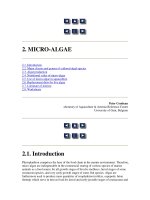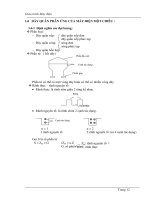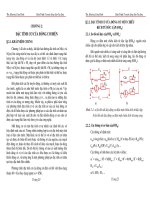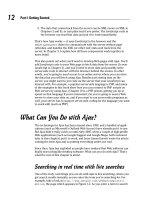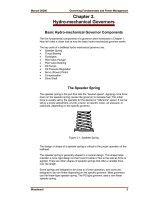Energy Management Handbook for Homeowners phần 2 doc
Bạn đang xem bản rút gọn của tài liệu. Xem và tải ngay bản đầy đủ của tài liệu tại đây (141.81 KB, 11 trang )
8
When buying an appliance, you pay more than just the selling price; you commit yourself to paying the cost
of running the appliance for as long as you own it.
These energy costs can add up quickly.
For example, running a refrigerator 15 to 20 years costs two to three times as much as the initial purchase price of
the unit; and the 100-watt light bulb you bought for 50 cents will cost about $6 in electricity over its short life.
Life-cycle Costing
The sum of the purchase price and the energy cost of running an appliance over its lifetime is called its life-cycle cost.
The life-cycle costs of energy-efficient appliances are lower than those of average models.
EnergyGuide Labels
When you shop for a major appliance, look for the yellow and black EnergyGuide labels (see page 9) that can help
you choose the most efficient model you can afford.
Appliance labeling was mandated by Congress as part of the Energy Policy and Conservation Act of 1975. Labels
must be displayed on seven types of major appliances. These seven major appliances account for about 73 percent of
all energy consumed in American homes. New appliance labeling rules, passed in 1994 by the Federal Trade
Commission to make energy-usage information easier to understand, began showing up on appliances on July 1, 1995.
The biggest change in the labeling of refrigerators, refrigerator/freezers, freezers, dishwashers, clothes washers and
water heaters is a switch in the comparison base from an estimated annual operating cost of the appliance to its annual
energy usage in kilowatt hours of electricity or therms of natural gas. Cost information will still be provided.
For Missouri residents in 1993, the average price for electricity was 7.3 cents/kWh and for natural gas was 53.5
cents/therm.
Federal law requires that EnergyGuide labels be placed on all new refrigerators, freezers, water heaters, dishwash-
ers, clothes washers, room and central air conditioners and heat pumps.
For additional information, you may contact the American Council for an Energy Efficient Economy or the Association
of Home Appliance Manufacturers for up-to-date information on appliance efficiency.
The American Council for an Energy Efficient Economy
1001 Connecticut Ave., NW, Suite 535
Washington, D.C. 20202
Phone (202) 429-8873
Association of Home Appliance Manufacturers
20 North Wacker Dr.
Chicago, IL 60606
Phone (312) 984-5800
Appliances
9
Appliances
The EnergyGuide Label
10
Selecting a Refrigerator/Freezer
The energy usage by refrigerators and freezers has decreased, but they are still among the largest energy users in
the home. In 1990 and 1993, National Appliance Efficiency Standards specified the maximum electricity consumption of
refrigerators according to volume and features.
When shopping for a new refrigerator or freezer, shop around using the EnergyGuide labels. There is still a wide vari-
ation in energy usage, and your choice of style and features will have an effect on energy usage. Side-by-side models
use more energy. Manual defrost models often use half as much energy as automatic defrost models but are not widely
available in large sizes. If you allow frost to build up, the refrigerator will rapidly lose efficiency. Features such as auto-
matic icemakers and through-the-door ice and water dispensers can increase energy consumption. Usually, the larger
the model, the greater the energy usage.
As a rule of thumb, you need eight cubic feet of refrigerator space for a family of two, plus one cubic foot for each
additional person. Add two cubic feet if you entertain a great deal. Two cubic feet per person is usually required in freez-
er space.
Operating Hints
• If possible, locate the refrigerator and freezer away from heat sources and direct sunlight. Allow at least one inch of
space on all sides of the refrigerator or freezer.
• Seriously evaluate the need for a second refrigerator. You may nearly double your electric bill.
•Arefrigerator or freezer in an unheated garage will use more electricity in the summer than the winter.
• Clean around the condenser once a year, and keep the coils and grills dust-free.
• If the model has an energy-saver switch, you can reduce the usage by about 10 percent. Heaters, used in humid cli-
mates as an anti-sweat feature, are not needed most of the year or in air conditioned homes. The switch for the
heaters may be labeled other than “energy saver.” If the switch has settings that say “dry/humid,” make sure it is set
on “dry.” If it is labeled “power miser” or “energy saver,” turn the switch “on” to turn the heaters off.
• Keep the door gasket clean and in good shape; replace if it is damaged.
• As a general rule, refrigerator thermostats should be set in the 32°F to 40°F temperature range. Usual temperature
of the freezer area in a conventional refrigerator is 10°F to 25°F; freezer sections of a refrigerator/freezer, about 5°F;
and separate freezers, 0°F.
•Avoid overcrowding, which reduces airflow.
•Avoid opening the doors often by planning ahead, and do not let the refrigerator door stand open.
• Let hot dishes cool slightly before putting in the freezer or refrigerator.
• In frost-free refrigerators, it is important to cover foods before placing them in the refrigerator.
• Thaw foods in the refrigerator instead of using the microwave.
• If you have a manual defrost freezer, keep the ice coating less than 1/4 inch for the most efficient operation.
•Turn off, empty, clean and leave the refrigerator door open when taking an extended vacation.
• Freezers operate most efficiently when they are at least 2/3 full.
Selecting a Washing Machine and Dryer
Like dishwashers, most of the energy used by washing machines is for heating water. Water heating accounts for
about 90 percent of total energy use. Most washing machines use from 30 to 40 gallons of water for a complete wash
cycle. The energy savings for reducing the water temperature are significant.
Model-to-model, the operation of dryers is very similar. The big choice is which type of fuel – electric or gas. In terms
of energy use, gas dryers are less expensive to operate. Electronic ignition is now required for all new gas dryers.
1. Shop around using the EnergyGuide labels.
2. Choose controls that allow you to select various water levels and water temperatures.
3. Consider a suds-saver feature (you can re-use wash water for additional loads).
4. Compare models for water usage, and buy the model with the lowest water usage in your price range.
5. Faster spin speeds can result in more water extraction and reduce drying time.
6. Front-loading (horizontal axis) machines use a third less water and have better washing performance.
Appliances
11
Operating Hints
WASHER
• The major cost of washing clothes is for heating water. Wash in cold or warm/cold cycles to save energy.
• Adjust the water level to match the size of the load.
• Always use a cold-water rinse.
DRYER
• Use a clothes line when possible; after drying, tumble in the dryer on air setting, to soften towels and clothes.
• Clean the lint filter after every load.
• Use the washer’s “sturdy clothes” spin cycle to remove as much water as possible before transferring clothes to the
dryer.
•Avoid over-drying.
• Use a tight-sealing dryer vent hood that blocks air infiltration.
•Vent the dryer to the outside.
Selecting a Dishwasher
Look for these energy-saving features when buying a new dishwasher:
1. An “air dry” selector. The heat is automatically shut off during the dry cycle. This can save up to 30 percent of the
electricity used by your dishwasher.
2. Short-cycle selectors. Use these cycles for lightly-soiled dishes as they use less hot water.
3. Less hot water usage. Dishwashers vary as to the number of gallons of hot water used per cycle. Approximately
80 percent of the energy used by a dishwasher is for heating the water; therefore, look for a model that uses less
water – between 8 and 14 gallons for a complete cycle.
4. Look for the yellow EnergyGuide label that should be on all dishwashers. This label will tell you the estimated
yearly cost of operation for that particular model.
5. Built-in water heaters. Some energy-conserving models have built-in water heaters that bring the water tempera-
ture up to the recommended level of 140°F. If you have this feature, the central water heater temperature can be
lowered. For each 10°F reduction in your water heater temperature setting, you cut energy consumption by 3 per-
cent to 5 percent.
Operating Hints
• Dishwashers use an average of 5.8 fewer gallons of water per load than washing the same dishes by hand.
•Wash only full loads.
•Avoid pre-rinsing by scraping off large food particles.
• Match the cycle to the degree of soil.
Appliances
12
Comfort Usage Cost in Dollars
Air Cleaner 1/20 kWh/hour $0.004
Air Conditioner, Central
(36,000 Btu, SEER 7) 5 kWh/hour 0.365
(36,000 Btu, SEER 10) 3 2/3 kWh/hour 0.268
(36,000 Btu. SEER 12) 3 kWh/hour 0.219
Air Conditioner, Room
(12,000 Btu, SEER 8) 1 1/2 kWh/hour 0.110
Electric Blanket 3/4 kWh/hour 0.055
Fan, Whole House 2/5 kWh/hour 0.029
Ceiling Fan 1/10 kWh/hour 0.007
Oscillating Fan 1/10 kWh/hour 0.007
Box or Window Fan 1/5 kWh/hour 0.015
Heat Lamp 1/4 kWh/hour 0.018
Heating Pad 1/3 kWh/hour 0.024
Fireplace Log, Gas, 33,000 Btu 1/3 therm/hour 0.178
Pilot Usage 1/5 therm/day 0.107
Floor or Wall Heater 1/3 Therm/hour 0.178
Furnace, Forced Air, Gas 1/2 kWh/hour+1Therm/Hour 0.572
Pilot Usage 6 Therm/month 3.210
Portable Heater, Electric, 1,500 watt 1 1/2 kWh/hour 0.110
Vaporizer, Steam 1/2 kWh/hour 0.037
Cool Mist 1/20 kWh/hour 0.004
Waterbed Heater 4 kWh/hour 0.292
Entertainment
Compact Disc Player 1/10 kWh/hour 0.007
Kiln 30 kWh/firing 2.190
Radio 1/2 kWh/hour 0.037
Sewing Machine 1/10 kWh/hour 0.007
Swimming Pool Filter Pump
(3/4 HP) 1 kWh/hour 0.073
Swimming Pool Heater 2 1/2 Therms/hour 1.338
Pilot Usage 1/4 Therm/day 0.134
Hot Tub 5 kWh/hour 0.365
TV, Black and White 1/20 kWh/hour 0.004
TV, Color 1/5 kWh/hour 0.015
(Instant-on Feature) 43 kWh/month 3.179
VCR 1/2 kWh/hour 0.037
Computer (PC)
Monitor (Color) 1/10 kWh/hour 0.007
Central Processing Unit 1/5 kWh/hour 0.015
Printer 1/5 kWh/hour 0.015
Appliances
APPLIANCE AND EQUIPMENT COST OF OPERATION
13
Grooming Usage Cost in Dollars
Curling Iron 1/100 kWh/use $0.001
Hair Curlers 1/10 kWh/use 0.007
Hair Dryer 1/4 kWh/use 0.018
Lighted Mirror 1/20 kWh/use 0.004
Shaving, Electric Razor 1 1/2 kWh/year 0.110
Elect. Water Heater, Blade Shave 1 kWh/shave 0.073
Gas Water Heater, Blade Shave 1/20 Therm/shave 0.027
Sun Lamp 2/5 kWh/hour 0.029
Toothbrush with Charger 10 kWh/year 0.730
Household Items
Clock 1 1/2 kWh/month 0.110
Dehumidifier 1/2 kWh/hour 0.037
Floor Polisher 1/3 kWh/hour 0.024
Heat Tape (10 ft.) 1/20 kWh/hour 0.004
Humidifier 1/10 kWh/hour 0.007
Sump Pump 1 kWh/hour 0.073
Vacuum Cleaner 2/3 kWh/hour 0.049
Well Pump 3 kWh/day 0.219
Laundry
Clothes Dryer, Electric 3 kWh/load 0.219
Clothes Dryer, Gas (1/4 Therm+1/6 kWh)/load 0.146
Steam Iron 1 kWh/hour 0.073
Washing Machine, Cold Water 1/4 kWh/load 0.018
Electricity for Hot Water 6 kWh/load 0.438
Gas for Hot Water 1/3 Therm/load 0.178
Water Heater, Electric 13 kWh/day 0.949
Water Heater, Gas 1 Therm/day 0.535
Pilot Usage 3 Therms/month 1.605
Lighting
Christmas Lights (50 Mini) 1/50 kWh/hour 0.001
Gas Yard Light (Single Mantle) 1/2 Therm/day 0.268
General Household 3 kWh/day 0.219
Mercury Vapor Light (150 watt)(10 hr night) 1 1/2 kWh/night 0.110
Night Light (7 watt) 2 1/2 kWh/month 0.183
Single Bulb (100 watt) 1/10 kWh/hour 0.007
Appliances
APPLIANCE AND EQUIPMENT COST OF OPERATION
14
Food Storage and Preparation Usage Cost in Dollars
Barbecue Grill (Gas) 1/4 Therm/hour $0.134
Broiler (Portable Electric) 1 1/2 kWh/hour 0.110
Can Opener 1/3 kWh/100 cans 0.024
Coffee Maker 1/5 kWh/brew 0.015
Corn Popper 1/10 kWh/use 0.007
Deep Fryer 1 kWh/use 0.073
Dishwasher 1kWh/load 0.073
Electricity for Hot Water 3 kWh/load 0.219
Gas for Hot Water 1/6 Therm/load 0.089
Electric Skillet 1 1/2 kWh/hour 0.110
Freezer, Frostless
15 cu ft Upright 5 kWh/day 0.365
15 cu ft Upright* 3 kWh/day 0.219
15 cu ft Chest Type 4 kWh/day 0.292
15 cu ft Chest Type* 2 1/2 kWh/day 0.183
15 cu ft Manual Defrost 3 kWh/day 0.219
Garbage Disposal 1/100 kWh/load 0.001
Ice Cream Freezer 1/10 kWh/use 0.007
Mixer 1/10 kWh/hour 0.007
Microwave Oven 1/10 kWh/10 min. 0.007
Oven, Electric 1 kWh/hour 0.073
Self Cleaning Feature 6 kWh/clean 0.438
Oven, Gas 1/10 Therm/hour 0.054
Self Cleaning Feature 1/2 Therm/clean 0.268
Range, Electric - Surface Unit 1 kWh/hour 0.073
Range, Gas - Surface Unit 1/20 Therm/hour 0.027
2 Pilot Lights 5 Therms/month 2.675
Refrigerator, Frostless
16 cu ft 5 kWh/day 0.365
16 cu ft* 2 1/2 kWh/day 0.183
23 cu ft Side-by-Side 10 kWh/day 0.730
23 cu ft Side-by-Side* 4 kWh/day 0.292
10 cu ft Manual Defrost 2 kWh/day 0.146
Slow Cooker 1 kWh/5 hrs. 0.073
Toaster 1/20 kWh/use 0.004
Toaster Oven 1/2 kWh/hour 0.037
Waffle Iron 1/3 kWh/use 0.024
Water Distiller 3 kWh/gallon 0.219
Appliances
*Post 1990 Energy-Efficient Models.
The estimated usage and costs are average figures. They do not apply to any particular installation or manufacturer’s
product and vary depending on individual operation. One kWh/hour is 1,000 watts of electricity used for one hour, such
as ten 100-watt lamps turned on for one hour. One kWh is equivalent to 3,412 Btus (British Thermal Units) of heat ener-
gy. One therm of natural gas, when burned, will produce 100,000 Btus of heat energy. One Btu is nearly equal to the
heat produced by burning one standard kitchen match.
The typical energy costs were computed using $.073 per kWh for electricity, $.535 per therm for natural gas and
$.687 per gallon for propane gas. The table may be used for evaluating the relative operating costs of various appli-
ances. Any cost totals from the above table should be corrected using your actual fuel costs.
Sources: Association of Home Appliance Manufacturers and Pacific Gas and Electric
APPLIANCE AND EQUIPMENT COST OF OPERATION
15
Heating is the largest energy expense in most homes. Reducing the energy used for heating is the single
most effective way to reduce the utility bill.
A combination of conservation efforts and a new, high-efficiency heating system can cut fuel bills in half without lower-
ing your comfort level.
The heating system replaces heat that is lost through the envelope of the house. How much heat is needed depends
on how big the house is, how cold and windy the winter is, the efficiency of the house, the efficiency of the heating sys-
tem and the habits of the family.
If there is a choice of heating fuels, the decision is generally based on economy of operation. The cost of operation is
not only based on the fuel cost but the efficiency of the heating system. Other factors that should be considered are the
system cost and the cost of fuel delivery (installing natural gas mains).
Forced-air Systems (Gas-fired)
Forced-air furnaces that deliver heated air to all parts of the home operate from a thermostat that signals burners to
ignite. When the air surrounding the heat exchanger in the plenum reaches a preset level, the electric-powered blower
comes on. Air from inside the house is pulled into the furnace cabinet through the return air duct. The air passes through
a filter and is circulated over the outside surface of the heat exchanger. The heat is transferred to this circulated air
through the heat exchanger walls and does not come in contact with the fuel or the products of combustion. A blower
forces the heated air circulating around the heat exchanger out of the furnace, through the ductwork, out the registers
and into the living space. Return air ducts carry the cooler room air back to the furnace where it is reheated. Both deliv-
ery and return air ducts should be well sealed and insulated where they pass through unheated areas.
When the desired room temperature is reached, the thermostat signals the burners to shut off. The blower continues
to operate until the furnace cools to a preset level and then shuts off. The plenum thermostat that controls the blower can
be set to come on at a lower temperature and stay on longer to move more heat into the home.
It is very important with forced-air systems to clean or change the filters monthly during the heating and cooling sea-
son. Older, natural gas forced-air systems have a continuously burning pilot to ignite the gas-air mixture. New, high-effi-
ciency furnaces have electronic ignition devices.
It is not a good idea to spend money for repairs on an older furnace. Existing forced-air furnaces have a seasonal effi-
ciency of about 60 percent; new systems have a seasonal efficiency of 80 percent to 95 percent. Changing an older sys-
tem to a new, high-efficiency system, instead of investing in repairs, should be done; however, replacing a working fur-
nace with a new high-efficiency model has a long pay-back time.
Hydronic Systems
Hydronic (hot water boiler) systems are less common. In this system, hot water from the boiler is circulated through
pipes to radiators in each room, then back to the boiler to be reheated. There is a pump at the boiler which circulates the
hot water from the boiler to the radiator. The thermostat usually controls the pump and burner and turns it on when the
house needs heat. The water starts circulating and continues until the thermostat setting is reached.
This type of heating system is a radiant system and does not have fans, which eliminates the chilling factor of moving
air. The system is more efficient because it does not have duct losses. For more efficient operation, a control can be
added to measure outside temperature and adjust the boiler temperature hotter as the outside temperature cools. Boilers
can be fueled by gas, electricity or even wood.
Heating
16
Combustion Air
The need for combustion air for gas-fired heating appliances must not be overlooked. Failure to provide adequate
combustion air will ultimately result in the production of carbon monoxide. Overall tightening of a dwelling could make a
home so tight that adequate combustion air would not be provided to the gas-fired appliance.
This illustration provides a rather simple method of providing combustion air to gas-burning heating appliances.
If your furnace draws combustion air from the crawl space, and you seal and insulate the crawl space, you need to be
sure adequate combustion air is provided by running a combustion air duct from a crawl space opening to the furnace.
Replacement Systems
When your existing gas furnace or boiler fails, you will need to replace it. There are a number of replacement fur-
naces to choose from, including many high-efficiency models. Over the lifetime of the heating system, the pay-back in
energy savings can be substantial.
How do you know which one to buy? First of all, check all the models available before you decide. We suggest getting
bids from several contractors.
EnergyGuide fact sheets are available from your heating contractor or dealer. These fact sheets will help you com-
pare models. Be sure to ask the heating contractor who replaces your furnace to run a heat loss calculation on your
home. This is needed to size the new unit correctly. A new furnace will probably have a lower Btu input rating.
If you replace your furnace, you will usually need a permit from the local building authority. Also, any time you have
work done on your furnace by a contractor, be sure he/she is licensed and has taken out all of the necessary permits, if
applicable.
It is seldom cost-effective to replace a working, existing furnace. The exception is an old coal stoker that has been
converted to natural gas. It should be replaced as soon as possible.
Heating
17
Electric Heating Systems
Electricity is a more expensive fuel than natural gas, so it is important to choose the most efficient electric heating sys-
tem you can afford.
Forced-air electric furnaces, employing resistance heating coils, are sometimes used in small homes and apart-
ments because they are less expensive up front, however, they cost more than twice as much to operate as electric heat
pumps.
Baseboard resistance heaters use a metal element to convert electricity to heat. Almost all of the electricity that
passes through the element is converted to heat.
The units are located in each room and usually have individual thermostats. By zone-heating, keeping only the room
you are using at a higher temperature, this type of heating cost can be reasonable.
Radiant panel heating may be located in the floor, walls or ceiling and may use electric resistance heating or hot
water from a central boiler. The heat is transferred by radiation and convection to the surrounding room.
If the radiant heating is located in the ceiling or floor, be sure the attic or foundation is adequately insulated. By the
same token, walls should be insulated behind the radiant panels to keep the heat inside the home. Radiant panel sys-
tems can be slow to respond to temperature changes.
Heat Pumps
Electric heat pumps have been available for home heating for more than thirty years. Essentially an air conditioner
running in reverse, heat pumps produce two to three units of heat energy for each unit of electrical energy consumed. A
seasonal efficiency rating for heat pumps has been devised by the U.S. Department of Energy (DOE). This rating, known
as the Heating Season Performance Factor (HSPF), equals the average heating capacity in Btu-per-hour divided by the
power consumption in watts. The efficiency of a heat pump increases with higher outdoor temperatures, therefore, sea-
sonal efficiencies are higher in warmer climates.
Most heat pumps employ the same basic layout and components as the equipment of 30 years ago. With the empha-
sis in the last decade on energy efficiency, and with the advent of solid state controls, today’s heat pump offers marked
improvements in efficiency and reliability. Because heat pumps also provide cooling in summer, consideration should also
be given to their cooling-efficiency rating or Seasonal Energy Efficiency Ratio (SEER). New developments in heat pumps,
including variable speed compressors and new compressor designs, are improving the HSPFs.
Air-to-air heat pumps are effective in winter at temperatures down to about 30°F. Supplemental heat is necessary at
temperatures below that.
Ground source heat pumps are the most efficient and most expensive in initial cost of electric heating systems.
These units use the ground, or ground water, as a heat source for warming, or a heat sink for cooling. Generally, ground
source heat pumps are installed at the time of construction or when retrofitting an existing air-to-air system.
Living with a Heat Pump
The heat pump delivers air at temperatures closer to room temperatures than conventional gas or electric furnaces.
Because a heat pump does not deliver hot blasts of air, some people will feel cool until they adjust to a heat pump-condi-
tioned environment.
The effectiveness of a heat pump is diminished by closing off unused rooms. Thus, the homeowner must heat all of
the home instead of only rooms used on a constant basis.
Special automatic thermostats must be purchased if you want to set back temperatures at night and during periods the
home is unoccupied. Without the special thermostat, the immediate several degree jump in the heating when the thermo-
stat is turned up requires the backup heat source (usually electric resistance heating), so the heat pump savings are
reduced.
If you are replacing an existing system with a heat pump, be sure to ask the contractor if your present ductwork will
have to be modified or replaced. Heat pumps require large ducts, and there should be several air returns. Both ducts and
returns should be insulated in all systems.
Heating
18
Leaky ducts are a serious problem in homes that use forced-air heating and air conditioning.
Distribution losses amount to 5 percent to 30 percent of the fuel consumed.
Duct sealing yields the biggest savings when the ducts are located in an unconditioned area that is well connected to
the outdoors. The outdoor air enters the return duct leaks, and heated or cooled air exits the supply ducts. This leakage
wastes energy. It also pressurizes and depressurizes areas of the home, providing a driving force for air leakage
throughout the building shell. When ducts are located in conditioned areas, duct leakage leads to some inefficiency and
local temperature differences, but isn’t a major energy problem. Return leaks are the trickiest to find and the most impor-
tant ones to seal, especially return leaks near the furnace. It is very important for the safety of the residents to seal ducts
thoroughly and to relieve pressure problems near combustion furnaces. A large return-air leak near the furnace can draw
flue gases down the chimney into the living space.
Duct Sealing
Duct sealing is an extremely important and often neglected energy management measure. The forced-air supply and
return ducts should be an airtight, closed system joining the furnace to the building. Duct joints should be sealed with
duct mastic between the furnace and ducts, between registers and floor, wall, or ceiling, and between duct sections.
Duct Insulation
Fiberglass is the most common insulation for ducts. Seams should be tight between pieces of insulation.
It is important to avoid insulation gaps and voids. The insulation should wrap all the way around the duct. Seal the
seams with a high-quality tape. Metal fasteners hold insulation in place better than tape. Fiberglass duct board and insu-
lated flexduct are duct materials with built-in insulation. They are not as durable as metal ducts but are easier to build
and install. Duct board and flexduct ducts must have a larger cross-sectional area compared to metal ducts, because
they are rougher inside and therefore create more air resistance. Flexducts should not be used for long runs.
Hot water or steam pipes should also be insulated.
Heating Ducts
